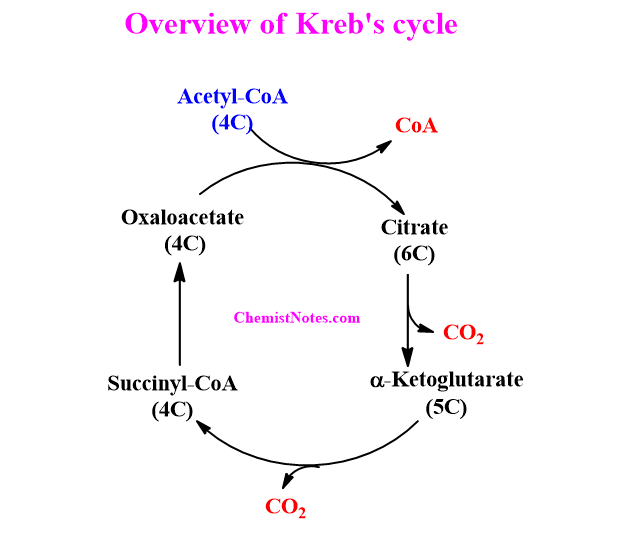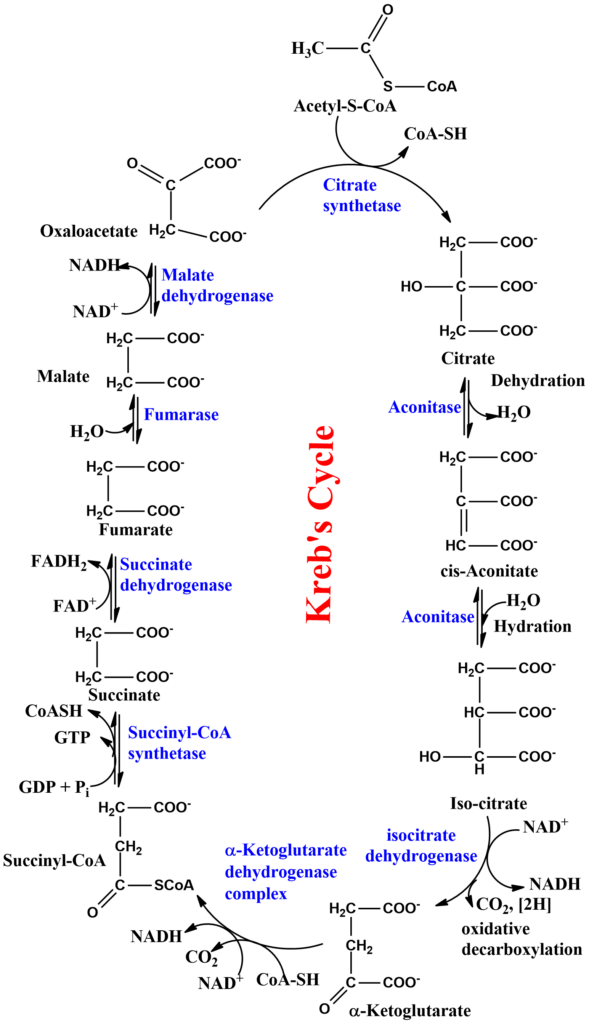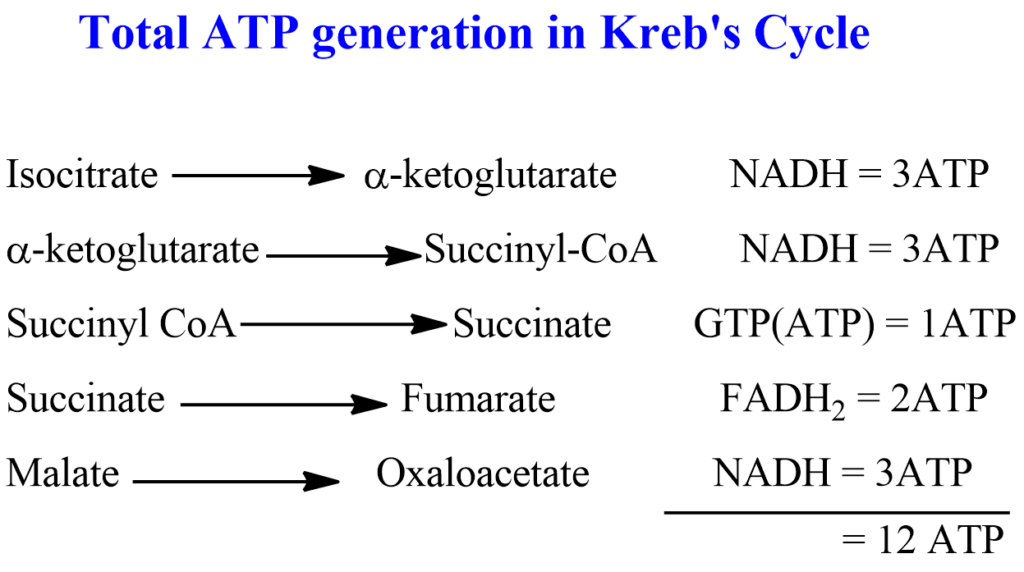Table of Contents
ToggleCitric acid cycle or TCA cycle or Kreb’s cycle
The citric acid cycle (CAC), also known as the TCA (tricarboxylic acid) cycle or Kreb’s cycle, is a series of chemical reactions to release stored energy through the oxidation of acetyl-CoA derived from carbohydrates, fats, and proteins into CO2 and H2O.
- The citric acid cycle was proposed by Hans Adolf Kreb in 1937, based on studies of oxygen consumption in pigeon breast muscle.
- About 65-70% of the ATP is synthesized in Kreb’s cycle, and it utilizes about two-thirds of the total oxygen consumed by the body.
- The Krebs cycle is used by organisms that respire (as opposed to organisms that ferment) to generate energy, either by anaerobic respiration or aerobic respiration.
- In addition, the cycle provides precursors for certain amino acids as well as the reducing agent NADH, which are used in numerous other reactions.
Kreb’s cycle basically involves the combination of a two-carbon acetyl-CoA with a four-carbon oxaloacetate to produce a six-carbon tricarboxylic acid, citrate. In the reaction that follows, the two carbons are oxidized to CO2, and oxaloacetate is regenerated and recycled. Oxaloacetate is considered to play a catalytic role in the citric acid cycle. An overview of Kreb’s cycle is shown below:

Steps and reactions of the citric acid cycle
The glycolysis process generates pyruvate. Before entering the citric acid cycle, pyruvate is converted to acetyl-CoA. The citric acid cycle occurs in eight steps, which are described below.
1) Formation of citrate
The first reaction of the cycle is the condensation of acetyl-CoA with oxaloacetate to form citrate, catalyzed by citrate synthetase. In this reaction, the methyl carbon of the acetyl group is joined to the carbonyl group (C-2) of oxaloacetate. Citroyl-CoA is a transient intermediate. It is formed on the active site of the enzyme and rapidly undergoes hydrolysis to yield free CoA and citrate, which are then released from the active site.
2) Formation of isocitrate via cis-aconitate
The enzyme aconitase, also known as aconitate hydratase, catalyzes the reversible transformation of citrate to isocitrate, through the cis-aconitate (tricarboxylic acid) intermediate. Aconitase can promote the reversible addition of H2O to the double bond of enzyme-bound cis-aconitate in two different ways, one leading to citrate and the other to isocitrate
3) Oxidation of isocitrate to α-ketoglutarate and CO2
In this step, isocitrate dehydrogenase catalyzes the oxidative decarboxylation of isocitrate to form α-ketoglutarate. There are two different forms of isocitrate dehydrogenase, one requiring NAD+ and the other requiring NADP+.
4) Oxidation of α-ketoglutarate to succinyl-CoA and CO2
This is another oxidative decarboxylation step, in which α-ketoglutarate is converted to succinyl-CoA and CO2 by the action of the α-ketoglutarate dehydrogenase complex, NAD+ serves as an electron acceptor.
5) Conversion of succinyl-CoA to succinate
Succinyl-CoA, like acetyl-CoA, has a strongly negative free energy of hydrolysis of its thioester bond (ΔG0 ≈ -36 KJ/mol). In the next step of the citric acid cycle, the energy released in the breakage of this bond is used to drive the synthesis of phosphoanhydride bonds in either GTP or ATP, and succinate is also formed in this process.
The enzyme that catalyzes the reversible reaction is called succinyl-CoA synthetase or succinic thiokinase.
6) Oxidation of succinate to fumarate
The succinate formed from succinyl-CoA is oxidized to fumarate by the flavoprotein succinate dehydrogenase.
In eukaryotes, succinate dehydrogenase is tightly bound to the inner mitochondrial membrane (in prokaryotes, to the plasma membrane); it is the only enzyme of the citric acid cycle that is membrane-bound.
Electron flow from succinate through these carriers to the final electron acceptor, O2 is coupled to the synthesis of two ATP molecules per pair of electrons. Malonate, an analog of succinate, is a strong competitive inhibitor of succinate dehydrogenase and therefore blocks the citric acid cycle.
7) Hydration of fumarate to produce malate
The reversible hydration of fumarate to L-malate is catalyzed by fumarase (fumarate hydratase). This enzyme is highly stereospecific; it catalyzes the hydration of the trans double bond of fumarate but does not act on malate, the cis-isomer of fumarate. In the reverse direction (from L-malate to fumarate), fumarase is equally stereospecific: D-malate is not a substrate.
8) Oxidation of malate to oxaloacetate
In the last reaction of the citric acid cycle, NAD-linked L-malate dehydrogenase catalyzes the oxidation of L-malate to oxaloacetate. The equilibrium of this reaction lies far to the left under standard thermodynamic conditions. However, in intact cells, oxaloacetate is continually removed by the highly exergonic citrate synthetase reaction.

Why is the citric acid cycle called a cycle?
The precursor of the citric acid cycle, oxaloacetate is regenerated at the end of the cycle, and the reaction proceeds continuously, so, the citric acid cycle or Kreb’s cycle is called a cycle.
Where does the citric acid cycle occur?
In eukaryotes, the citric acid cycle occurs in the mitochondrial matrix. However, due to the lack of mitochondria in prokaryotic cells, the citric acid cycle, or TCA cycle occurs in the cytoplasm.
The enzymes of the TCA cycle are located in the mitochondrial matrix, in close proximity to the electron transport chain. This enables the synthesis of ATP by oxidative phosphorylation without any hindrance.
Inputs and outputs of the citric acid cycle
The inputs of the citric acid cycle are derived from the outputs of the glycolysis cycle. The acetyl-CoA and oxaloacetate are the inputs of the citric acid cycle whereas oxaloacetate is the output of the citric acid cycle. With oxaloacetate, the citric acid cycle also produces energy equivalent to 12 ATP in the form of NADH, FADH2, and GTP (ATP).
Irreversible steps of citric acid cycle
Citric acid cycle or TCA cycle contains 3 irreversible steps, which are as follows:
- Condensation of oxaloacetate and acetyl-CoA to form citrate.
- Decarboxylation of iso-citrate to α-ketoglutarate.
- Decarboxylation of α-ketoglutarate to succinyl-CoA.
Energetics of citric acid cycle
During the process of oxidation of acetyl CoA via the citric acid cycle, 4 reducing equivalents (3 as NADH and one as FADH2) are produced. Oxidation of 3 NADH by the electron transport chain coupled with oxidative phosphorylation results in the synthesis of 9 ATP, whereas FADH2 leads to the formation of 2 ATP. Besides, there is substrate-level phosphorylation. Thus, a total of twelve ATPs are produced from one acetyl CoA.

Role of vitamins in TCA cycle
Four B-complex vitamins are essential for the Krebs cycle and, thus, energy generation.
- Thiamine (as TPP) as a coenzyme for D-ketoglutarate dehydrogenase.
- Riboflavin (as FAD) as a coenzyme for succinate dehydrogenase.
- Niacin (as NAD+) is an electron acceptor for isocitrate dehydrogenase, D-ketoglutarate dehydrogenase, and malate dehydrogenase.
- Pantothenic acid (as coenzyme A) attached to active carboxylic acid residues, i.e., acetyl CoA, succinyl CoA.
Regulation of citric acid cycle
The cellular demands of ATP are crucial in controlling the rate of the citric acid cycle. The regulation is brought about either by enzymes or the levels of ADP. Three enzymes—namely citrate synthase, isocitrate dehydrogenase, and D-ketoglutarate dehydrogenase—regulate the citric acid cycle.
- Citrate synthase is inhibited by ATP, NADH, acetyl CoA, and succinyl CoA.
- Isocitrate dehydrogenase is activated by ADP, and inhibited by ATP and NADH.
- D-ketoglutarate dehydrogenase is inhibited by succinyl CoA and NADH.
- The availability of ADP is very important for the citric acid cycle to proceed. This is due to the fact that unless sufficient levels of ADP are available, oxidation (coupled with phosphorylation of ADP to ATP) of NADH and FADH2 through the electron transport chain stops. The accumulation of NADH and FADH2 will lead to the inhibition of the enzymes and also limit the supply of NAD+ and FAD which are essential for the TCA cycle to proceed.
Which process connects glycolysis and the citric acid cycle?
A transition reaction which involves the conversion of 3-carbon pyruvate to 2-carbon acetyl-CoA) connects glycolysis and the citric acid cycle.
Rate limiting step of citric acid cycle
Since, isocitrate dehydrogenase is an allosterically controlled enzyme, the conversion of isocitrate to α-ketoglutarate catalyzed by isocitrate dehydrogenase is a rate-limiting step of the citric acid cycle.
Why does the citric acid cycle operate only under aerobic conditions?
The citric acid cycle operates only under aerobic conditions because NAD+ and FAD can be regenerated in the mitochondria only from the transfer of electrons to molecular oxygen. Thus, oxygen is necessary for this process.
Calvin cycle vs citric acid cycle
Calvin cycle is an anabolic pathway for the synthesis of glucose. It is a light-independent cycle. Whereas citric acid cycle or TCA cycle is a catabolic process and produces reduced co-enzymes like ATP, NADH, and FADH2.
Similarly, the Calvin cycle occurs only in photosynthetic eukaryotes and in photosynthetic bacteria. On the other hand, the citric acid cycle occurs in all types of prokaryotes and animals. Calvin cycle occurs in the stroma (inner space of chloroplast) whereas, the citric acid cycle occurs in the mitochondrial matrix of eukaryotes and in the cytoplasm of prokaryotes.
Citric acid cycle enzymes mnemonic
“Cool Aunt In Kathmandu Sells Special Fish and Meat”
C = Citrate Synthetase
A = Aconitase
I = Isocitrate dehydrogenase
K = α-Ketoglutarate dehydrogenase
S = Succinyl CoA synthetase
S = Succinate dehydrogenase
F = Fumarase
M = Malate dehydrogenase
Mnemonics for citric acid cycle
“Angry Crow Is Again Singing, Sweet, Funny, and Melody Oh ooo.”
A = Acetyl CoA
C = Citrate
I = Isocitrate
A = alpha-Ketoglutarate
S = Succinyl-CoA
S = Succinate
F = Fumarate
M = malate
O = oxaloacetate
FAQs/MCQs:
Does the citric acid cycle produce CO2?
Yes, the citric acid cycle produces two molecules of CO2, the first molecule in the conversion of isocitrate to α-ketoglutarate and the second molecule in the conversion of α-ketoglutarate to succinyl-CoA.
What are the reactants of the citric acid cycle?
The reactants of the citric acid cycle are acetyl-CoA and oxaloacetate.
How many NADH is produced in the citric acid cycle?
3 molecules of NADH are produced in one turn of the citric acid cycle.
Where does the citric acid cycle occur in prokaryotes?
In prokaryotes, the citric acid cycle occurs in the cytoplasm.
Which electron carrier functions in the citric acid cycle?
FADH+ and NAD+ electron carrier functions in the citric acid cycle.
How many FADH2 are produced in citric acid cycle?
In one turn of the citric acid cycle, 1 molecule of FADH2 is produced.
What compounds are needed to start the citric acid cycle?
Acetyl-CoA and oxaloacetate are the starting compounds of the citric acid cycle.
What is another name for the citric acid cycle?
Citric acid cycle is also known as the TCA (tricarboxylic acid) cycle or Kreb’s cycle.
How many CO2 is produced in the citric acid cycle?
Two molecules of CO2 are produced in the single turn of the citric acid cycle.
Where does the citric acid cycle occur in eukaryotes?
In eukaryotes, the citric acid cycle occurs in the mitochondrial matrix.
Step 3 of the citric acid cycle is…
Oxidation of isocitrate to α-ketoglutarate.
Which step connects glycolysis to the citric acid cycle?
Transition reaction (conversion of pyruvate to acetyl-CoA) connects glycolysis to the citric acid cycle.






